Abstract
The paper assesses the rate of digitalization implemented in the business sector in the context of digital transformation models of foreign countries and the Russian Federation. Despite similar goals of business digitalization in different countries, the methods and ways of achieving these goals, as well as the outcomes, are different. This is due to different priorities, national programs geared to the innovation sector and digitalization of the business sector. One of the most informative indicators to assess the rate and effectiveness of business digitalization is Business Digitalization Index. The paper analyzes the behavior of this index and indicators by which Business Digitalization Index for 2017–2018 is built in Russia and a number of foreign countries. The Scandinavian countries such as Finland, Norway, Sweden, Denmark and some other European countries are the leading states in terms of the effectiveness of business digitalization. The Scandinavian countries take leading positions not only in the rate of digital technologies adopted in the business sector, but also in a number of other indicators demonstrating the level of digitalization of the state, such as Digital Evolution Index, etc. The paper discusses the models of the digital economy in the Scandinavian countries for increasing the effectiveness of digital technologies integrated in the business sector. This can be used to manage the digital transformation of the business sector at the level of the Russian Federation and its regions.
Keywords: Business digitalization, models of digital transformation of the economy, cloud computing, Enterprise Resource Planning, broadband Internet, international ranking
Introduction
In modern economic environment, digital technologies are developing at a tremendous speed, changing the ways and conditions of doing business. Being influenced by growing trends in the digitalization of the economy, the business processes of entrepreneurial structures are being transformed through digital tools (Dimitriadi et al., 2019; Kuzminov et al., 2018).
The rate of business digitalization is different in different countries. What is more, states are taking different paths in developing their own digital economy. Some are developing mainly the digital sector, among which are Russia and the United Kingdom. Others are focusing on the digitalization of production, such as Germany. A number of states, like China, Finland, etc. are following the path when state initiative is dominant, and others, like the United States – private initiatives (Sannikova et al., 2019). Digital transformation models in different countries have their own specific features.
Problem Statement
Business digitalization in modern economic conditions is a completely natural and simply necessary prerequisite to ensure business sector of any developed state. This is due to a number of circumstances. Firstly, the use of computers and related equipment, the Internet, any communications, etc. is simply a prerequisite for any entrepreneur to function. Secondly, business digitalization solves a number of tasks in the activities of an entrepreneur, such as establishing closer relations with suppliers and customers, increasing the level of its own operational efficiency, increasing the competitiveness of manufactured products (Lukyanova, 2019). Thirdly, digital technologies are crucial for increasing labor productivity, availability of information, and reducing costs. Fourthly, digitalization of business sector is a kind of objective circumstance that the entrepreneur faces, caused by the global digitalization of national economies of most countries.
Assessing the rate of business digitalization in the context of digital transformation models in different countries is an urgent research topic, since it enables to adopt best practices.
Research Questions
Assessing the rate of digitalization integrated into the business sector, with the experience and models of digital transformation in Russia and some foreign countries.
Purpose of the Study
Conducting a comparative assessment of the rate of digitalization integrated in the business sector in Russia and a number of foreign countries, with the available foreign experience of leading countries in this area, particularly the models of digital transformation of these states.
Research Methods
Research methods and techniques are based on the material on the rate and effectiveness of digitalization implemented in the business sector of Russia and a number of foreign countries, on the models of digital transformation in countries with high results of the adoption of digital technologies in the business sector, as well as on research data. The tasks set were solved based on the application of general scientific research methods in the framework of comparative, logical, statistical analysis and graphic interpretation.
Findings
Despite similar goals of business digitalization in different countries, the methods and ways of achieving these goals, as well as the outcomes, are different. This is due to different priorities, national programs geared to the innovation sector and digitalization of the business sector. One of the most informative indicators to assess the rate and effectiveness of digitalization in the business sector is Business Digitalization Index.
Figure 1 presents Business Digitalization Index to assess the rate and effectiveness of digitalization implemented in the business sector in Russia and a number of foreign countries.
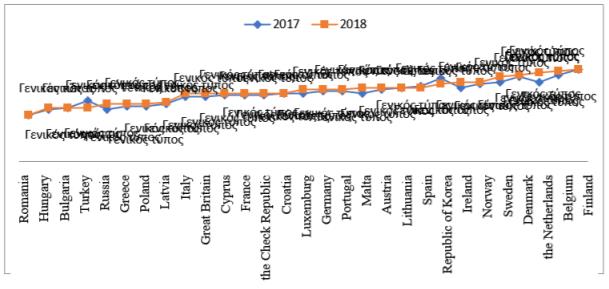
In terms of the effectiveness of business digitalization, the leading states are the Scandinavian countries, including Finland (50 %), the Netherlands (48 %), Norway (43 %), Sweden (46 %), Denmark (47 %) and a number of other European countries. In terms of the spread of digital technologies in the business sector, Russia ranks last, with Business Digitalization Index to make up 31 % in 2018.
Business Digitalization Index is based on several indicators, embracing the rate of cloud computing, broadband Internet, RFID, ERP and involvement in online shopping.
The rate of cloud computing in Russia and a number of foreign countries is shown in Figure 2.
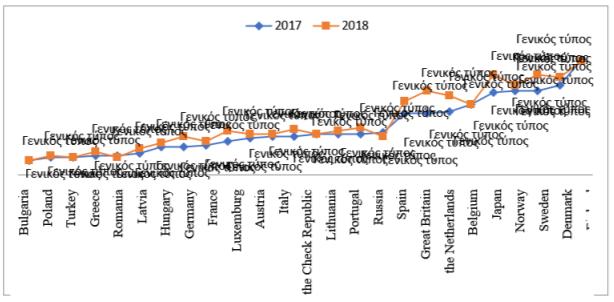
In this respect, Russia occupies a very good position. 27 % of organizations used cloud computing in 2018, which is 17.4 % higher than in 2017.
There is was growth rate in the share of organizations in the business sector using broadband Internet in Russia from 82 % in 2017 to 86 % in 2018. The rate of broadband Internet used by the business sector in Russia is not high, as compared with a number of foreign countries (Fig. 3).
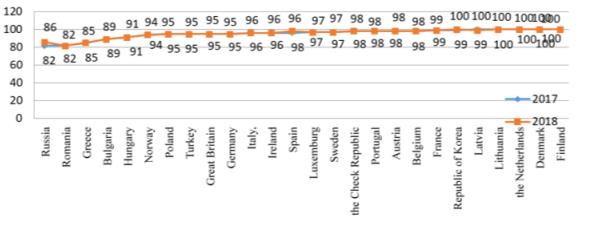
100 % of business organizations in Finland, Belgium, Denmark, the Netherlands, Lithuania, and Latvia use broadband Internet. In 2010-2018, the rate of broadband Internet used by Russian business sector increased by 35 %.
As compared to some foreign countries, significantly fewer business organizations in Russia use RFIDs, only about 6 % (Fig. 4).
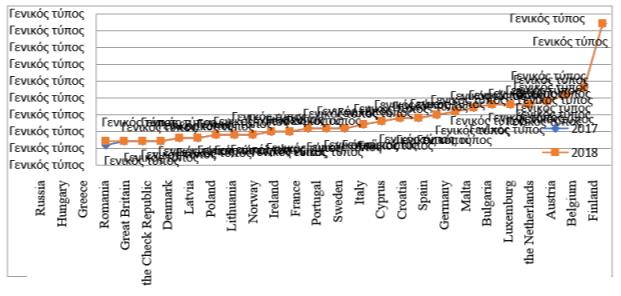
Figure 5 shows the rate of ERPs used in Russia in comparison with some other foreign countries.
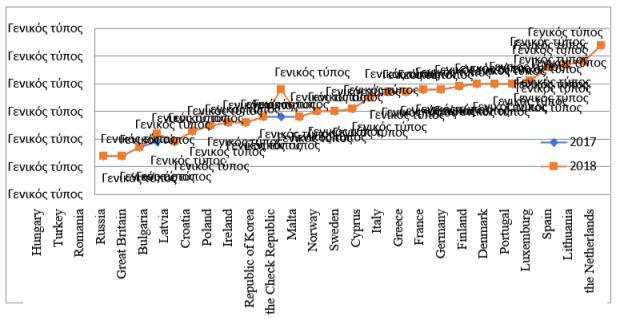
The rate of online shopping by the business sector in most countries is growing (Fig. 6).
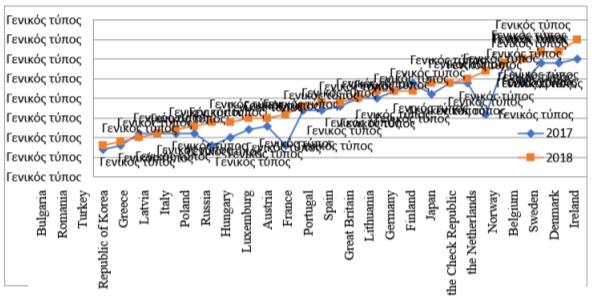
is the leader in terms of business digitalization. Its Business Digitalization Index is 50, with the country having 100 % coverage of organizations using broadband Internet. More than half of organizations use cloud services, more than a third – ERPs, about ¼ of organizations – online shopping and RFIDs. Finland ranks among the global leaders in terms of R&D investment. Finland is one of the first states to adopt the concept of national investment system as a crucial ingredient of science and technology policy. At the state level, the Ministry of Education and the Ministry of Trade and Industry are responsible for science and technology policy. Universities, the Academy of Finland and the Technology Development Center (Teknologian Keskus) are central to research funding in Finland. Among the most serious projects of this center is the creation of strategic centers of competence, namely Metsaklustery Oy (timber industry), Tivit Oy (industry, etc.), Fimec Oy (metalworking) and others.
has a very high level of digitalization in the business sector. In terms of Business Digitalization Index, the country is in 2nd place with a value of 48 % in 2017: 100 % coverage of organizations with broadband Internet, more than half of organizations use cloud services. There has been a significant increase in online shopping by the Dutch entrepreneurial sector from 16 % in 2016 to 27 % in 2017. There are nine leading sectors in the country with targeted funding (over 80 % of R&D), aimed at creating an enabling environment. These sectors include agriculture, food processing, horticulture, high-tech systems and materials, energy, logistics, creative industries, chemicals, water resources, and life sciences.
is one of the leaders among EU member states in terms of Business Digitalization Index (47 %). In four out of five analyzed indicators, Denmark is more than 2 times ahead of the Russian Federation, except for the use of broadband Internet. What is more, Denmark provides the 100 % broadband Internet coverage of the business sector. In addition, almost the entire population of Denmark uses the Internet for online services, banking, online shopping, etc. Denmark is a leader in 4G and NGA connectivity and fixed broadband coverage (Melnichuk, 2019).
Denmark has adopted the new Strategy for Denmark's Digital Growth. In 2011, the Danish government adopted Denmark That Stands Together, a strategy for the country’s development until 2050, which reflects issues related to new forms of cooperation between politicians, enterprises, volunteers, the public sector and citizens of the state. Denmark actively supports the digital sector, in particular, through budgetary funding. In 2017, about 27 million euros were allocated to the Small Broadband Fund alone, which finances the development of 5G projects. Tax deductions in the business sector are widely used in the country. In particular, in 2016, a tax deduction was presented in Denmark for the costs associated with installing or upgrading broadband. The country is actively attracting private investment from regional and local companies. Since 2011, Denmark has had a unified digital development strategy. About 98 % of business and population requests come to government agencies through online services, which led to the release of about $ 136 million annually (Sannikova et al., 2019).
leading position on these issues is not surprising. R&D funding as a percentage of the GDP has been one of the highest in the world for many years. In Sweden, there is a strong relationship between entrepreneurs and universities in the field of research. There are several organizations responsible for innovative development of the business sector. Among them is the Swedish Agency for Economic and Regional Growth that provides direct support to small and medium-sized enterprises and newly established organizations. The leading government agency for innovative development in Sweden is the Swedish Government Agency for Innovation Systems. Among government organizations that finance research in many areas is the Swedish Research Council (Balashova & Shpolyanskaya, 2015). An interesting fact is that Sweden fairly provides special tax breaks for entrepreneurs.
Business Digitalization Index was 43 % in 2018. The state takes an active part in supporting the innovative activity of the business sector. The cost of innovation in the country is lower than the EU average. However, the state invests 55 % of the total investment in innovative business (Mamedyarov, 2016). In comparison, in Germany, France and the Netherlands the state contribution is 30 %, Great Britain and Italy – 20 %. The structure of costs for innovative developments in the country is interesting. 90 % is spent on innovative developments in the manufacturing and service industries. This aims to reduce dependence on traditional industries for Norway. Since 2002, the country has had a Skattefunn credit tax support system for small and medium-sized businesses, and since 2003 – for enterprises of various scales of activity (Mikhailova, 2015).
In, 86 % of organizations use broadband Internet. A little more than ¼ use cloud services, only 7 % – RFIDs, less than a quarter – ERPs. Unlike other foreign countries, Russia has a very low level of online shopping. The country is on a par with Greece, Poland, ahead of Bulgaria and Romania.
A low contribution of digital technologies to the country’s economy clearly demonstrates the impact of digital technologies on Russia’s GDP, which amounted to 3.9 % in 2016. In contrast, in the US this figure was 10.9 %, in China – 10 %, EU countries – 8.2 %, Brazil – 6.2 %, India – 5.5 %. According to experts, even if the volume of investment in digital technologies in Russia increases to a level that is the average for the sample among the leading countries, then by 2025 the share of the digital economy may amount to about 10 % of the GDP. For comparison, in China, the estimated growth by 2025 is up to 22 % of the GDP (Semerina & Solomina, 2018).
The rate of digital technologies integrated in the business sector depends heavily on digital literacy of the population. In Russia, 42 % of the population is quite good at MS Word, unlike the UK with 65 % of the population, Sweden – 70 %, the Czech Republic – 58 %. About 21 % of the population of Russia knows how to use programs for editing photo, video and audio files, which is more than 2 times lower than in most European countries. Only 27 % of the population is able to transfer files between a computer and a peripheral device, which is 2 times lower than in Europe. The share of the population of the Russian Federation using the Internet for financial transactions (31 %), job search (10 %), online shopping (29 %) is not high; it is 2–3 times lower than in most European countries (Abdrakhmanova et al., 2019).
The Scandinavian countries take leading positions not only in the effectiveness of digital technologies integrated in the business sector, but also in a number of other indicators that demonstrate the rate of digitalization across the state (Voroncova et al., 2019). According to data for 2017, in terms of the rate of current digital development and growth rate of digitalization of the economies of the surveyed countries, assessed against Digital Evolution Index, Norway, Sweden, Denmark, and Finland occupy 1, 2, 4 and 5 places in the ranking among 60 countries (Strokatov, 2019).
According to Digital Evolution Index 2017, which shows the development of the digital economy of countries, as well as the rate of integration of the Internet into the life of the population, most of the Scandinavian countries are at the forefront. Norway is in first place. Finland and Denmark are in the top ten. However, in terms of digital development, these same states are among the slowing growth rates. Russia, on the other hand, is among the countries that are promising or breakthrough in terms of digital development.
Conclusion
A comparative analysis of the rate and effectiveness of business digitalization in Russia and some other countries demonstrates serious prospects and horizons that Russian entrepreneurs have yet to master in the field of business digitalization. From the point of view of the pace of digital development, the country is among the breakthrough countries, which is characterized by a low level of digital development, but this fact is also attractive for investors, since the country is rapidly developing, and will develop in the future.
The rate of development of digital technologies is influenced by the status of the country’s economy as such, the digital skills of the population, measures taken by the authorities, scientific activities of educational institutions, and many other factors. It is impossible to solve the issues of business digitalization without the system of economic relations and institutions, clearly substantiated and well-developed directions of state economic policy. This should be done addressing the features of the state and regions, along with current advanced foreign experience.
References
Abdrakhmanova, G. I., Baskakova, O. E., Vishnevsky, K. O., & Gokhberg L. M. (2020). Trends in the Development of the Internet in Russia and Foreign Countries. NRU HSE.
Abdrakhmanova, G. I., Vishnevsky, K. O., & Gokhberg, L. M. (2019). Digital Economy. HSE Data Book. Moscow National Research University Higher School of Economics. https://www.hse.ru/data/2019/06/25/1490054019/ice2019.pdf
Balashova, S. A., & Shpolyanskaya, A. A. (2015). Administrative and Economic Mechanisms for Ensuring Innovative Development (Experience of Germany and the Scandinavian countries). National interests: priorities and security, 47, 53–66
Dimitriadi, N. A., Dzhukha, V. M., & Mishurova, I. V. (2019). Information component of the development process of business strategy by modern Russian manufacturing companies. Europ. Proc. of Soc. and Behavioral Sci., 80, 68-76.
Kuzminov, A. N., Dzhukha, V. M., Ternovsky, O. A., Mikhnenko, T. N. (2018). Cenological Measurement of Productive Efficiency. Europ. Res. Stud. J., XXI(Spec. Iss. 3B).
Lukyanova, A. V. (2019). Trends and Opportunities for Digitalization of Small and Medium Business. https://www.esa-conference.ru
Mamedyarov, Z. A. (2016). Norway: Results of State Support for R&D Forecasts. https://www.imemo.ru/news/events/text/norvegiya-rezulytati-gosudarstvennoy-podderzhki-niokr
Melnichuk, M. V. (2019) International Experience in the Development of the Digital Economy in the Countries of the European Union. Econ. and Law, 6, 97–103
Mikhailova, A. A. (2015). Features of the Innovation Policy of the Developed Countries of the Baltic Region Forecasts. htpp://abfund.org/osobennosti-innovatsionnoj-politiki-razvity-h-stran-baltijskogo-regiona/
Sannikova, T. D., Bogomolova, A. V., & Zhigalova, V. N. (2019). Foreign Models of Digital Transformation and Prospects for their Use in Russia. J. of Int. Econ. affairs, 2, 481–494.
Semerina, S. A., & Solomina, I. V. (2018). Digital Transformation of Business: Foreign Experience. Bulletin of Samara University. Econ. and Manag., 9(2), 25–31.
Strokatov, D. A. (2019). Scandinavian Countries in International Rankings in the Field of ICT. Int. trade and trade policy, 4(19).
Voroncova, О. V., Mamontova, U. P., & Gritsunova, S. V. (2019). Development of international cooperation in power engineering. J. IOP Conf. Ser. Mater. Sci. and Engineer.
Copyright information

This work is licensed under a Creative Commons Attribution-NonCommercial-NoDerivatives 4.0 International License.
About this article
Publication Date
17 May 2021
Article Doi
eBook ISBN
978-1-80296-106-5
Publisher
European Publisher
Volume
107
Print ISBN (optional)
-
Edition Number
1st Edition
Pages
1-2896
Subjects
Science, philosophy, academic community, scientific progress, education, methodology of science, academic communication
Cite this article as:
Dzhukha, V. M., Surzhikov, M. A., Gritsunova, S. V., & Sedykh, Y. A. (2021). Digitalization Implemented In Business Sector In Context Of Digital Transformation Models. In D. K. Bataev, S. A. Gapurov, A. D. Osmaev, V. K. Akaev, L. M. Idigova, M. R. Ovhadov, A. R. Salgiriev, & M. M. Betilmerzaeva (Eds.), Knowledge, Man and Civilization - ISCKMC 2020, vol 107. European Proceedings of Social and Behavioural Sciences (pp. 2017-2025). European Publisher. https://doi.org/10.15405/epsbs.2021.05.267

